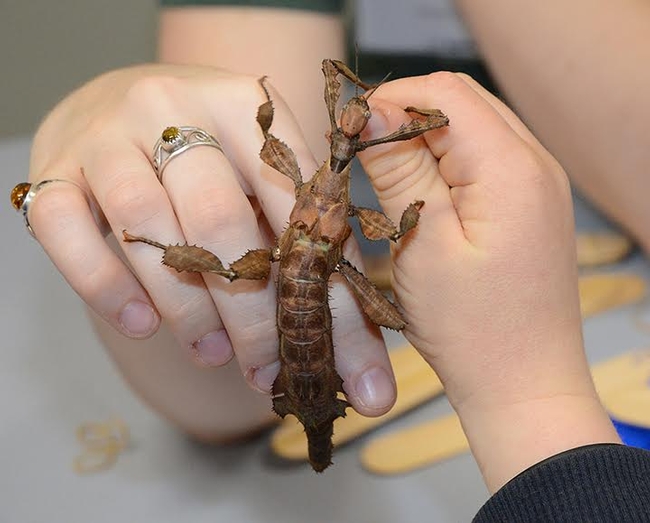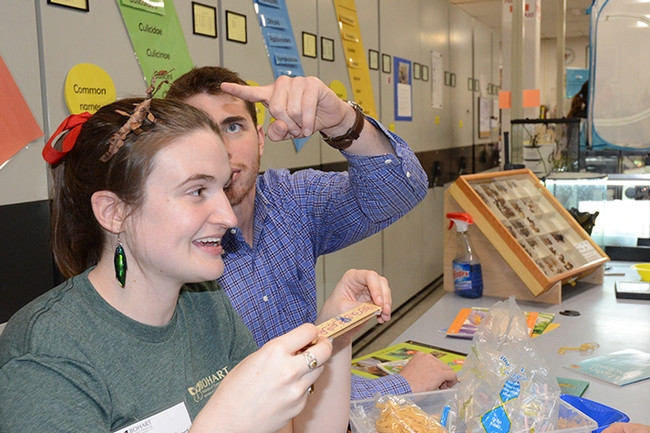
So when the Bohart Museum of Entomology open house, themed "Keep Calm and Insect On," took place last Saturday, an Australian walking stick, Extatosoma tiaratum, got into the act. It promptly walked from the hand of entomology graduate student Charlotte Herbert to her head and pretended to be a barrette. A Phasmid barrette.
This one was a sultry brown female adult stick insect with a decidedly spiked "hairdo." Spiked? The females are covered with thornlike spikes, used for defense as well as camouflage.
According to Wikipedia, "Both sexes, when threatened, stand on the front and middle legs, pointing their abdomen up or to the side in a sort of 'scorpion' pose. They fold back their legs to defend themselves if anything comes in contact with their abdomen. Adults can release a defensive odor that humans might not find offensive as it "is rather reminiscent of peanut butter, vinegar or toffee."
Many of the visitors at Saturday's open house at first overlooked the stick insect barrette. After all, it was camouflaged. But they quickly grasped Charlotte Herbert's enthusiasm for insects as she shared information and encouraged them to ask questions and hold the insects. In between, she led a workshop on how to make buzz kazoos.
"I have known since I was five years old that I wanted to be an entomologist," Herbert said. "Growing up on a farm in New Hampshire allowed me to fall in love with the natural world and the critters that exist in it. To this day, I love nature and especially insects. There is something extraordinarily beautiful about their small size and complexity."
"Four years ago I started to follow my passion of entomology beyond the hobbyists perspective and into research during my undergraduate at St. Lawrence University, Canton, N.Y. Even though my undergraduate school did not offer a degree in entomology, my advisor Dr. Karl McKnight took me under his wing and allowed me to conduct independent entomological research. It was there that I fell in love with the fly (Diptera) family Asilidae, also known as assassin flies or robber flies. There are over 7,500 species of assassin flies found worldwide. They are incredibly diverse, venomous, and aggressive aerial predators"
For the past two years Herbert worked with assassin flies at the Smithsonian's National Museum of Natural History. This fall she became a Ph.D student in Lynn Kimsey's lab and a volunteer at the Bohart Museum of Entomology. Kimsey directs the Bohart Museum and is a professor of entomology in the UC Davis Department of Entomology and Nematology.
"I am so happy to be at UC Davis!" Herbert said. "I am following my lifelong passion of entomology, surrounded with other like-minded individuals, and get the pleasure of working at the Bohart, where I can teach people to set aside their fears of insects and instead glimpse into their incredibly complex and beautiful world."
There definitely was no fear when visitors got acquainted with the walking stick in her hair and the one in her hand.
The Bohart Museum, located in Room 1124 of the Academic Surge Building on Crocker Lane, is home to nearly eight million specimens, as well a "live" petting zoo, with critters like Madagascar hissing cockroaches, walking sticks and a rose-haired tarantula named "Peaches." It also operates a gift shop filled with T-shirts, insect collecting equipment, posters, books, insect-themed candy and jewelry.
Throughout the academic year, the Bohart hosts an open house on specified weekends. The remaining open houses:
- Sunday, Jan. 10 from 1 to 4 p.m.: Parasitoid Palooza II
- Saturday, Feb. 13: Biodiversity Museum Day
- Saturday, April 16, 10 a.m. to 3 p.m.: UC Davis Picnic Day
- Saturday, July 31, 8 to 11 p.m.: “Celebrate Moths”
Attached Images:

Graduate student Charlotte Herbert, who is seeking her doctorate in entomology from UC Davis, has a visitor in her hair--a stick insect barrette. (Photo by Kathy Keatley Garvey)

George Alberts of Los Angeles points to a "barrette" in the hair of his friend, UC Davis entomology graduate student and Bohart volunteer Charlotte Herbert. (Photo by Kathy Keatley Garvey)